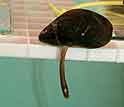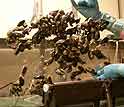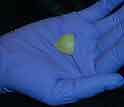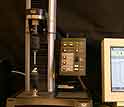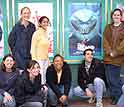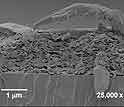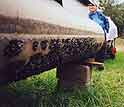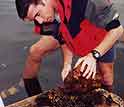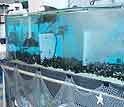News Release 04-002
Chemists Crack Secrets of Nature's Super Glue
Mussel-powered proteins stick to Teflon, even under water
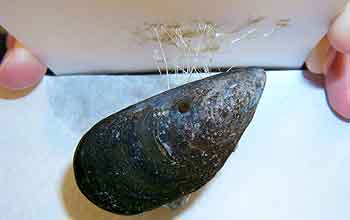
Common blue mussel (Mytilus edulis) hangs tough.
January 12, 2004
This material is available primarily for archival purposes. Telephone numbers or other contact information may be out of date; please see current contact information at media contacts.
ARLINGTON, Va.—Researchers have discovered that iron in seawater is the key binding agent in the super-strong glues of the common blue mussel, Mytilus edulis. This is the first time researchers have determined that a metal such as iron is critical to forming an amorphous, biological material.
In addition to using the knowledge to develop safer alternatives for surgical and household glues, the researchers are looking at how to combat the glue to prevent damage to shipping vessels and the accidental transport of invasive species, such as the zebra mussel that has ravaged the midwestern United States.
National Science Foundation CAREER awardee Jonathan Wilker, Mary Sever and their colleagues at Purdue University announce their discovery in the Jan. 12 issue of Angewandte Chemie.
En route to crafting synthetic versions of the glue, the researchers discovered that bivalves extract the metal iron from the surrounding seawater and use it to join proteins together, linking the fibrous molecules into a strong, adhesive mesh. The 800 mussels in Wilker's laboratory have an uncanny ability to stick to almost anything, even Teflon®.
Comment from Wilker regarding research:
"Mussel glues present the first identified case in which transition metals are essential to the formation of a non-crystalline biological material," says NSF CAREER awardee Jonathan Wilker of Purdue University.
"We are curious as to whether or not this newly discovered, metal-mediated protein cross-linking mechanism of material formation is a prevalent theme in biology. We will be exploring systems such as barnacle cement, kelp glue and oyster cement to see how other biomaterials are produced," says NSF CAREER awardee Jonathan Wilker of Purdue University.
"The biological origin of this glue and the ability to stick to nearly all surfaces invite applications such as the development of surgical adhesives," says NSF CAREER awardee Jonathan Wilker of Purdue University.
"Understanding how marine glues are formed could be key to developing surfaces and coatings to prevent adhesion processes. Current antifouling paints rely upon releasing copper into surrounding waters, thereby killing barnacles in their larval state. We are hoping our results will help make antifouling paints that do not require the release of toxins into the marine environment," says NSF CAREER awardee Jonathan Wilker of Purdue University.
NSF comments regarding the research discovery and the Wilker group:
"It appears that the strength, sticking power and endurance of these extraordinary biological materials may derive from inorganic chemistry," says chemist Mike Clarke, the NSF program officer who oversees Wilker's award.
"Proteins often rely on metal ions to tie them together and provide stability, but this is the first time that a transition metal ion has been determined to be an integral part of a biological material," says chemist Mike Clarke, the NSF program officer who oversees Wilker's award.
"The research wonderfully illustrates the potential for metal ions to strengthen materials by cross-linking polymer chains. More important to researchers is the tantalizing suggestion that the remarkable adhesive properties of these biological glues lie in an iron-dependent oxidation to radicals," says chemist Mike Clarke, the NSF program officer who oversees Wilker's award.
"This discovery could lead to the creation of unusual new materials with designed plasticity, strength and adhesiveness for household, structural and biological uses. Perhaps, these properties could even be made dependent upon electrochemical potential thereby creating new vistas for electronic materials," says chemist Mike Clarke, the NSF program officer who oversees Wilker's award.
-NSF-
-
Common blue mussel (Mytilus edulis) from coastal Maine extends its foot for the camera.
Credit and Larger Version -
The small colony of common blue mussels adhered to this glass plate.
Credit and Larger Version -
A sample of the natural glue extract before it is cured.
Credit and Larger Version -
Wilker and his colleagues use a "tensile tester" to test the strength of the mussel glues.
Credit and Larger Version -
Wilker and his colleagues use the tensile tester and clamps to test the ability of the glue.
Credit and Larger Version -
Jonathan Wilker (center) with his laboratory team.
Credit and Larger Version -
The mussel glue, or plaque, as imaged by a scanning electron microscope.
Credit and Larger Version -
The hull of this pontoon boat is encrusted with zebra mussels.
Credit and Larger Version -
Jonathan Wilker collecting zebra mussels from a freshwater lake in northeast Indiana.
Credit and Larger Version -
The 150-gallon tank that Wilker's more than 800 common blue mussels call home.
Credit and Larger Version
Additional Resources:
Principal Investigator: Jonathan Wilker, (765) 496-3382, wilker@purdue.edu
Purdue University Media Officer: Chad Boutin, (765) 494-2081, cboutin@purdue.edu
Wilker Research Group Web Site: http://www.chem.purdue.edu/wilker/
Purdue University News: http://news.uns.purdue.edu
NSF CAREER Award homepage: http://www.nsf.gov/home/crssprgm/career/start.htm
The Faculty Early Career Development (CAREER) Program is a Foundation-wide activity that offers the National Science Foundation’s most prestigious awards for new faculty members. The CAREER program recognizes and supports the early career-development activities of those teacher-scholars who are most likely to become the academic leaders of the 21st century. CAREER awardees will be selected on the basis of creative, career-development plans that effectively integrate research and education within the context of the mission of their institution. NSF encourages submission of CAREER proposals from new faculty at all CAREER eligible institutions. Such plans should build a firm foundation for a lifetime of integrated contributions to research and education.
Media Contacts
Josh Chamot, NSF, (703) 292-7730, email: jchamot@nsf.gov
Program Contacts
Mike Clarke, NSF, (703) 292-4967, email: mclarke@nsf.gov
The U.S. National Science Foundation propels the nation forward by advancing fundamental research in all fields of science and engineering. NSF supports research and people by providing facilities, instruments and funding to support their ingenuity and sustain the U.S. as a global leader in research and innovation. With a fiscal year 2023 budget of $9.5 billion, NSF funds reach all 50 states through grants to nearly 2,000 colleges, universities and institutions. Each year, NSF receives more than 40,000 competitive proposals and makes about 11,000 new awards. Those awards include support for cooperative research with industry, Arctic and Antarctic research and operations, and U.S. participation in international scientific efforts.
Connect with us online
NSF website: nsf.gov
NSF News: nsf.gov/news
For News Media: nsf.gov/news/newsroom
Statistics: nsf.gov/statistics/
Awards database: nsf.gov/awardsearch/
Follow us on social
Twitter: twitter.com/NSF
Facebook: facebook.com/US.NSF
Instagram: instagram.com/nsfgov



